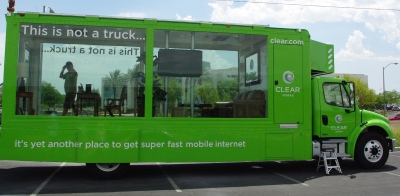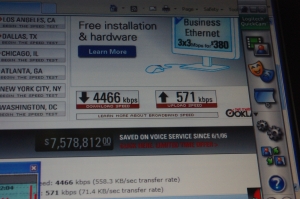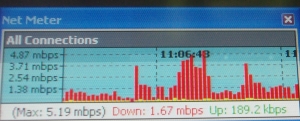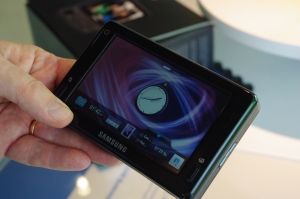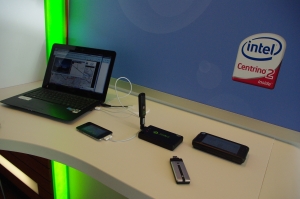The State of Mobile WiMAX: How Good is CLEAR?
The 4G era is upon us. Or at least some of us. Yesterday, Clearwire officially launched its 638-square mile Mobile WiMax network in the Las Vegas market, which will enable 1.7 million residents to surf at speeds that put today's 3G connections to shame. We've already gone hands on in Baltimore with CLEAR, but we were excited to see how those data rates stacked up in Sin City. The bottom line: it's fast on the downlink, and we like the aggressive pricing plans, but upload speeds could be better.
We had a chance to spend a few hours on location in the new CLEAR retail store and also spend some time riding around town with Clearwire’s chief commercial officer Mike Sievert and Las Vegas general manager for Clearwire Jeremy Abler to test the network’s real-world performance using the latest WiMAX certified devices.
Test Drive
Mobile WiMAX is great for in-car entertainment or driving around town, but CLEAR advertises its service as an alternative for DSL or Cable.
For our first test of the network, we drove around Las Vegas for about a half hour testing various applications on an in-car computer system that Clearwire configured beforehand. To enable the car with CLEAR WiMAX, Clearwire outfitted it with a CLEAR USB Modem ($59.99 or $4.99 per month with a lease and a $30 monthly data plan) and plugged that into one of the car’s included USB ports.
We started out with a simple ooVoo video chat with a computer that was setup in the CLEAR retail store and found the video quality to be quite good, despite a few drops down to speeds as low as 48.8Kbps. As we drove around, a Net Meter application monitored our throughput rates.
Fast Downloads, Mediocre Uploads
Much of the time, we saw data speeds hovering around 2-3 Mbps with a peak data throughput speed of 5.19 Mbps. That’s a bit shy of the promised 3-6Mbps but still considerably faster than traditional 3G broadband networks. When we did a speed test, we saw an impressive average download speed of 4.36 Mbps.
Sign up to receive The Snapshot, a free special dispatch from Laptop Mag, in your inbox.
On the upload, we saw a somewhat poky average speed of 571 Kbps. While that rate is a bit above CLEAR's advertised range, we've seen upload speeds in excess of 1 Mbps from 3G connection cards like the AT&T USBConnect Mercury (though we didn't test that card in Vegas). These relatively slow data upload speeds could be one of the biggest drawbacks of Mobile WiMAX right now, and a major reason why we wouldn’t want it to replace our current home Internet connection.
Streaming Video
We were told that the in-car computer system didn’t have the processing power to provide a good multi-tasking experience for running a video call and a Hulu clip at the same time, so we cut off our ooVoo conversation and played a Dave Matthews
clip on Hulu.
Audio and video quality was excellent, especially given Hulu’s limited buffering, but we lost our connection twice during the music video while traveling at 55Mph. Given CLEAR’s plans to provide service in Las Vegas limousine and transportation service vehicles, this could become frustrating for someone trying to get some work done in the back seat. CLEAR expects to be able to handle the initial load of customers in the market and says it is ready to upgrade its towers for heavier load as more people join the network.
Attractive Pricing Plans
Perhaps the most enticing thing about CLEAR is its pricing plan. Instead of being locked into one- or two-year contracts like you would with your current wireless carrier, you can sign up for monthly or daily passes. A 2GB monthly pass—which is below what we’d recommend for anyone streaming video—will set you back $35 with a $35 activation fee (waived if you sign up for a 2-year contract). Each additional GB costs just $10 if you happen to go over your bill; that’s a lot friendlier than the $51.20 that each additional GB would cost you if you went over on a 5GB plan on a traditional carrier.
An unlimited plan costs $40 per month, and you can use either an in-home modem (Motorola’s Clear Modem will set you back $79.99 or you can lease it monthly for $4.99) or a portable WiMAX device like the Samsung Mondi or Clear Spot. If you’d like to use both an in-home connection and a mobile solution, you can sign up for a $45 monthly plan and swap between the devices as you go.
CLEAR also offers a $10 day pass, so if you’re a business traveler and find yourself in one of its markets frequently, you can buy a dongle and then just sign up for the service when you’re in town.
Our only beef with the pricing plans is CLEAR's dual-band 3G/4G monthly subscription price with Sprint. If you want to switch between 3G and 4G networks, expect to pay data plans for both, or a total of $80 per month with a 2-year service agreement. That's too high for our tastes, but we assume some mobile professionals will be willing to pay the premium.
New Advertising Push
Initially, one of our biggest concerns for CLEAR is how Clearwire will position the network to new customers. With all the talk of Long-Term Evolution (LTE) and High Speed Packet Access Evolved (HSPA+) from AT&T, T-Mobile, and Verizon Wireless, what will attract customers to sign up for a data plan with a company that’s not their wireless voice provider? CLEAR’s answer is that its 4G network is here, and it’s here now. CLEAR also says that it will advertise heavily in Baltimore to let XOHM customers know about the name change.
Clearwire will also be working with local radio stations and parking its CLEAR demo-truck around town, which people can walk around inside and test the network on a variety of gadgets.
Devices
Clearwire plans to launch retail stores in its new markets as the WiMAX footprint grows. Inside, there will be a host of WiMAX capable gadgets ranging from the Samsung Mondi to notebooks and netbooks, plus USB adapters customers can purchase. In WiMAX markets, these gadgets will also be available from big box retailers like Best Buy or RadioShack and online.
One of the more promising devices is the Clear Spot Personal Hotspot ($139). It works similarly to the Verizon Wireless MiFi Mobile HotSpot by rebroadcasting a Mobile WiMAX signal as a Wi-Fi one so that any Wi-Fi capable gadget ranging from iPod touches to notebooks can log on. While it’s bulkier than the MiFi device and only sports 2-3 hours of battery life (versus 4 hours for the MiFi), up to 8 users can log on to share the faster WiMAX data network.
An Aggressive Outlook
Today mobile WiMAX is available in Baltimore, Portland, and Atlanta, but we’re told that Baltimore isn’t yet a ‘CLEAR’ branded network and still remains XOHM until CLEAR has a chance to make a few additional upgrades. By the end of 2010, however, CLEAR expects to expand its network to 80 markets. That roster includes Chicago, Charlotte, Dallas, Honolulu, Philadelphia, and Seattle in 2009 and Boston, Houston, New York, San Francisco, and New York in 2010.
Verizon Wireless says that it will begin rolling out its 4G LTE network during the second half of 2010, and AT&T has stated that it plans to make its LTE network available in 2011 with testing to begin in 2010.
Final Thoughts
There are a few questions that consumers will have to ask themselves while considering CLEAR gear and data plans. First, where will you be using the equipment? If you’re planning on being in a CLEAR market for a long period of time, then the increased data speeds could be attractive for working on-the-go without having to worry about finding a Wi-Fi hotspot. However, if you’re a frequent traveler, you may want to consider one of CLEAR’s dual-band devices like the CLEAR 4G+ mobile, which will fall back to Sprint’s 3G network outside of the WiMAX network (assuming you're willing to pay $80 per month).
Second, what will you be using WiMAX for? If you’re browsing the Web or watching videos, you can expect very good performance (despite the few cut-outs we experienced). But if you’re planning on uploading lots of videos, that 500 Kbps rated upload speed isn’t going to cut it.
It’s exciting to see that Mobile WiMAX is finally here and ready to go in a big city like Las Vegas. And the pricing plans will be attractive to customers that don’t want to necessarily sign a contract. We also like that CLEAR's data speeds (on the downlink) outclass today's 3G networks. However, the upload speeds are a bit of a letdown.
The biggest challenge for Clearwire will be in meeting its goal to roll out its WiMAX service to those 80 new markets by the end of 2010, and in packaging more attractive pricing plans that combine 4G and 3G coverage to help fill in the gaps until coverage is widespread.
